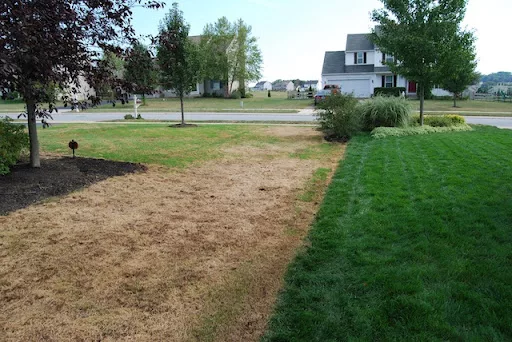
Photo - naturallawnandlandscape.com
Because of stress to turf this year including damage from Fall Armyworm, your lawn may be looking sparse, thin, and weedy. If so, now is a great time to consider lawn renovation. Making the decision between renovating and reestablishing a lawn is simple. If at least half of your lawn is comprised of desirable turf, renovation techniques can be successful. However, if less than half is desirable turf or if an invasive grass-weed such as bermudagrass has taken over your lawn, reestablishment is necessary.
The first step in lawn renovation is to determine and correct the problem that led to the decline in lawn quality. Some factors include: diseases, low soil fertility, weed competition, soil compaction, and excessive thatch.
To determine the fertility and pH of your soil, a soil test is required. Samples may be taken with a hand trowel from 10 or more locations throughout the renovation area at a depth of 3 to 4 inches. These samples are mixed together and a representative sample from the mix can be brought in to the county Extension office. Within a few weeks you will receive the results which state your soil’s current pH, how much lime is required to change the pH, and the lawn’s fertility needs including how much, what type of fertilizer, and when to apply.

A healthy, dense lawn will have few weed problems. But if a turf has suffered diseases or other stresses, weeds can easily creep in and take hold. Broadleaf weeds, such as dock or plantain, can be controlled using herbicides containing 2,4-D, MCPP, and dicamba. This product will control broadleaf weeds without damaging your turf. Annual grass-weeds, such as crabgrass and goosegrass, must be controlled by applying a pre-emergence herbicide in the spring.
Lawns that are heavily compacted can benefit from the use of a core aerifer. Unlike the other aerifiers that use solid tines to make holes in the lawn (this actually leads to more compaction rather than alleviating compaction), core aerifiers have hollow tines that cut round holes in the ground 2 to 3 inches deep and then deposit those soil cores on the surface. Moist soils will allow for deeper tine penetration but soils that are too wet may clog the hollow tines. Soil cores can be left on the surface to break down naturally or broken-up with a rake after they dry.
For seeds to germinate and grow properly they must be in contact with the soil. This sounds simple but in many lawns, a thick layer of thatch makes seed to soil contact extremely difficult. Thatch is the accumulation of grass clippings, roots and stems that form a dense layer at the soil surface. This layer can harbor insects, diseases, and effect air and water movement through the soil. A thatch layer thicker than 1/3 inch should be removed to improve seed germination.
Raking is typically insufficient at removing the thatch layer, therefore mechanical dethatching is recommended. Power rakes is one type of dethatching machine that removes thatch using power-driven spring tines that rotate and rip the thatch out of the ground. These can be adjusted to slightly scratch the soil surface to ensure good seed contact. Vertical mowers are similar to power rakes except they have blades that cut groves through the thatch into the soil. These are often considered better than power rakes since they cut deeper into the soil and provide a good surface for seed establishment. Thatch pulled to the surface should be removed and a second pass with the equipment will produce closely spaced groves that catch broadcasted seed.
Grass selection is generally based on personal preference, however, the newer turf-type tall fescue varieties have been bred for disease resistance, drought, and cold tolerance, color, and other qualities that standard varieties, such as Kentucky 31, lack. One method of seed selection is to choose a blend of fescues. Blends typically combine three or more of the top turf-type varieties giving you better success in a lawn that has variable growing conditions (i.e., shade, poor drainage, disease problems).
Research results on grass varieties can be found on-line at www.ntep.org. Grass seed should be applied to a renovated lawn at a rate of 2.5 to 5 lbs per 1,000 square feet. Bare spots or areas prone to erosion may require straw mulch applied at a rate of 80 to 100 lbs per 1,000 square feet. Keep your overseeded areas moist with frequent but shallow irrigations (two to three times daily) for the first two to three weeks after planting. After grasses are 2 inches tall, change your watering practice to less frequently but with more water to increase rooting depth. Grasses can be mowed as soon as the tallest plants reach 3 inches tall.
Interested in learning more about lawn care? Why not join the Master Gardener Program. Training in Christian County starts September 13. Contact the Christian County Extension Office for an application at 270-886-6328.
— Kelly Jackson, Christian County Extension Agent





